Baseline Groundwater Quality before Shale Gas Development in Xishui, Southwest China: Analyses of Hydrochemistry and Multiple Environmental Isotopes (2H, 18O, 13C, 87Sr/86Sr, 11B, and Noble Gas Isotopes)
Abstract
1. Introduction
2. Study Area and Sampling
3. Experiment and Analyses
4. Results and Discussion
4.1. Baseline Values of Shallow Groundwater
4.1.1. Hydrochemistry
4.1.2. Isotopes of Oxygen, Hydrogen, Carbon, Strontium, and Boron
δ18O and δ2H
δ13C-DIC
87Sr/86Sr
δ11B
4.2. Origin of Dissolved Gas
4.2.1. Compositions of Dissolved Gas
4.2.2. Carbon and Helium Isotopes
4.3. Sensitive Indicators for Monitoring Groundwater
4.3.1. Sensitive Indicators
4.3.2. Method for Identifying Pollution
5. Conclusions
Author Contributions
Funding
Acknowledgments
Conflicts of Interest
References
- Estrada, J.M.; Bhamidimarri, R. A review of the issues and treatment options for wastewater from shale gas extraction by hydraulic fracturing. Fuel 2016, 182, 292–303. [Google Scholar] [CrossRef]
- Zou, C.; Zhao, Q.; Chen, J.; Li, J.; Yang, Z.; Sun, Q.; Lu, J.; Zhang, G. Natural gas in China: Development trend and strategic forecast. Nat. Gas. Ind. 2018, 38, 1–11. [Google Scholar] [CrossRef]
- Shale Gas Planning. Available online: http://zfxxgk.nea.gov.cn/auto86/201609/t20160930_2306.htm (accessed on 15 September 2019).
- Zou, C.; Dong, D.; Wang, Y.; Li, X.; Huang, J.; Wang, S.; Guan, Q.; Zhang, C.; Wang, H.; Liu, H.; et al. Shale gas in China: Characteristics, challenges and prospects (II). Pet. Explor. Dev. 2016, 43, 166–178. [Google Scholar] [CrossRef]
- China Geological Survey. The Shale Gas. Resources in China; China Geological Survey: Beijing, China, 2015; pp. 1–23.
- Wang, R.; Hu, Z.; Long, S.; Liu, G.; Zhao, J.; Dong, L.; Du, W.; Wang, P.; Yin, S. Differential characteristics of the Upper Ordovician–Lower Silurian Wufeng–Longmaxi shale reservoir and its implications for exploration and development of shale gas in/around the Sichuan Basin. Acta Geol. Sin. Engl. 2019, 93, 520–535. [Google Scholar] [CrossRef]
- Yang, R.; Chen, W.; Zhou, R. Characteristics of organic-rich shale and exploration area of shale gas in Guizhou Province. Nat. Gas. Geosci. 2012, 23, 340–347. [Google Scholar]
- Zhang, B.; Yao, L.; Luo, S.; Zhao, Y.; Sun, W. Current status and outlook of shale gas exploration and development in Guizhou Province. Nat. Gas. Technol. Econ. 2016, 10, 57–59. [Google Scholar]
- Zhang, B.; Han, Z.; Zhang, W.; Si, F. Research on shale gas of Wufeng–Longmaxi Formation, Guizhou Province. Nat. Gas. Technol. Econ. 2017, 11, 19–23. [Google Scholar]
- Vengosh, A.; Warner, N.; Jackson, R.; Darrah, T. The effects of shale gas exploration and hydraulic fracturing on the quality of water resources in the United States. Procedia Earth Planet. Sci. 2013, 7, 863–866. [Google Scholar] [CrossRef]
- Vengosh, A.; Jackson, R.B.; Warner, N.; Darrah, T.H.; Kondash, A. A critical review of the risks to water resources from unconventional shale gas development and hydraulic fracturing in the United States. Environ. Sci. Technol. 2014, 48, 8334–8348. [Google Scholar] [CrossRef]
- Vengosh, A.; Kondash, A.; Harkness, J.; Lauer, N.; Warner, N.; Darrah, T.H. The geochemistry of hydraulic fracturing fluids. Procedia Earth Planet. Sci. 2017, 17, 21–24. [Google Scholar] [CrossRef]
- Osborn, S.G.; Vengosh, A.; Warner, N.R.; Jackson, R.B. Methane contamination of drinking water accompanying gas-well drilling and hydraulic fracturing. Proc. Natl. Acad. Sci. USA 2011, 108, 8172–8176. [Google Scholar] [CrossRef] [PubMed]
- Gagnon, G.A.; Krkosek, W.; Anderson, L.; McBean, E.; Mohseni, M.; Bazri, M.; Mauro, I. Impacts of hydraulic fracturing on water quality: A review of literature, regulatory frameworks and an analysis of information gaps. Env. Rev. 2016, 24, 122–131. [Google Scholar] [CrossRef]
- Wilson, M.P.; Worrall, F.; Davies, R.J.; Hart, A. Identifying groundwater compartmentalisation for hydraulic fracturing risk assessments. Environ. Sci. Proc. Impacts 2019, 21, 352–369. [Google Scholar] [CrossRef] [PubMed]
- Howarth, R.W.; Ingraffea, A.; Engelder, T. Should fracking stop? Nature 2011, 477, 271–275. [Google Scholar] [CrossRef] [PubMed]
- Vidic, R.D.; Brantley, S.L.; Vandenbossche, J.M.; Yoxtheimer, D.; Abad, J.D. Impact of shale gas development on regional water quality. Science 2013, 340, 1235009. [Google Scholar] [CrossRef]
- Zhang, D.; Yang, T. Environmental impacts of hydraulic fracturing in shale gas development in the United States. Pet. Explor. Dev. 2015, 42, 801–807. [Google Scholar] [CrossRef]
- Jackson, R.B.; Vengosh, A.; Darrah, T.H.; Warner, N.R.; Down, A.; Poreda, R.J.; Osborn, S.G.; Zhao, K.; Karr, J.D. Increased stray gas abundance in a subset of drinking water wells near Marcellus shale gas extraction. Proc. Natl. Acad. Sci. USA 2013, 110, 11250–11255. [Google Scholar] [CrossRef]
- Siegel, D.I.; Azzolina, N.A.; Smith, B.J.; Perry, A.E.; Bothun, R.L. Methane concentrations in water wells unrelated to proximity to existing oil and gas wells in northeastern Pennsylvania. Environ. Sci. Technol. 2015, 49, 4106–4112. [Google Scholar] [CrossRef]
- Wen, T.; Niu, X.; Gonzales, M.; Zheng, G.; Li, Z.; Brantley, S.L. Big groundwater data sets reveal possible rare contamination amid otherwise improved water quality for some analytes in a region of Marcellus shale development. Environ. Sci. Technol. 2018, 52, 7149–7159. [Google Scholar] [CrossRef]
- Wen, T.; Castro, M.C.; Nicot, J.P.; Hall, C.M.; Larson, T.; Mickler, P.; Darvari, R. Methane sources and migration mechanisms in shallow groundwaters in Parker and Hood Counties, Texas—A heavy noble gas analysis. Environ. Sci. Technol. 2016, 50, 12012–12021. [Google Scholar] [CrossRef]
- Wen, T.; Castro, M.C.; Nicot, J.P.; Hall, C.M.; Pinti, D.L.; Mickler, P.; Darvari, R.; Larson, T. Characterizing the noble gas isotopic composition of the Barnett Shale and Strawn Group and constraining the source of stray gas in the Trinity Aquifer, north-central Texas. Environ. Sci. Technol. 2017, 51, 6533–6541. [Google Scholar] [CrossRef] [PubMed]
- Rahm, B.G.; Riha, S.J. Evolving shale gas management: Water resource risks, impacts, and lessons learned. Environ. Sci. Proc. Impacts 2014, 16, 1400–1412. [Google Scholar] [CrossRef] [PubMed]
- Harkness, J.S.; Darrah, T.H.; Warner, N.R.; Whyte, C.J.; Moore, M.T.; Millot, R.; Kloppmann, W.; Jackson, R.B.; Vengosh, A. The geochemistry of naturally occurring methane and saline groundwater in an area of unconventional shale gas development. Geochim. Cosmochim. Acta 2017, 208, 302–334. [Google Scholar] [CrossRef]
- Barth-Naftilan, E.; Sohng, J.; Saiers, J.E. Methane in groundwater before, during, and after hydraulic fracturing of the Marcellus Shale. Proc. Natl. Acad. Sci. USA 2018, 115, 6970–6975. [Google Scholar] [CrossRef] [PubMed]
- Botner, E.C.; Townsend-Small, A.; Nash, D.B.; Xu, X.; Schimmelmann, A.; Miller, J.H. Monitoring concentration and isotopic composition of methane in groundwater in the Utica Shale hydraulic fracturing region of Ohio. Env. Monit. Assess. 2018, 190, 322. [Google Scholar] [CrossRef]
- Jackson, R.E.; Gorody, A.W.; Mayer, B.; Roy, J.W.; Ryan, M.C.; Van Stempvoort, D.R. Groundwater protection and unconventional gas extraction: The critical need for field-based hydrogeological research. Ground Water 2013, 51, 488–510. [Google Scholar] [CrossRef]
- Siegel, D.I.; Smith, B.; Perry, E.; Bothun, R.; Hollingsworth, M. Pre-drilling water-quality data of groundwater prior to shale gas drilling in the Appalachian Basin: Analysis of the Chesapeake Energy Corporation dataset. Appl. Geochem. 2015, 63, 37–57. [Google Scholar] [CrossRef]
- Montcoudiol, N.; Banks, D.; Isherwood, C.; Gunning, A.; Burnside, N. Baseline groundwater monitoring for shale gas extraction: Definition of baseline conditions and recommendations from a real site (Wysin, Northern Poland). Acta Geophys. 2019, 67, 365–384. [Google Scholar] [CrossRef]
- Brantley, S.L.; Vidic, R.D.; Brasier, K.; Yoxtheimer, D.; Pollak, J.; Wilderman, C.; Wen, T. Engaging over data on fracking and water quality. Science 2018, 359, 395–397. [Google Scholar] [CrossRef]
- Son, J.H.; Hanif, A.; Dhanasekar, A.; Carlson, K.H. Colorado Water Watch: Real-time groundwater monitoring for possible contamination from oil and gas activities. Env. Monit. Assess. 2018, 190, 138. [Google Scholar] [CrossRef]
- Bordeleau, G.; Rivard, C.; Lavoie, D.; Lefebvre, R.; Malet, X.; Ladeveze, P. Geochemistry of groundwater in the Saint-Edouard area, Quebec, Canada, and its influence on the distribution of methane in shallow aquifers. Appl. Geochem. 2018, 89, 92–108. [Google Scholar] [CrossRef]
- Smedley, P.L.; Ward, R.S.; Bearcock, J.M.; Bowes, M.J. Establishing the baseline in groundwater chemistry in connection with shale-gas exploration: Vale of Pickering, UK. Procedia Earth Planet. Sci. 2017, 17, 678–681. [Google Scholar] [CrossRef]
- Li, Y.; Huang, T.; Pang, Z.; Wang, Y.; Jin, C. Geochemical characteristics of shallow groundwater in Jiaoshiba shale gas production area: Implications for environmental concerns. Water 2016, 8, 552. [Google Scholar] [CrossRef]
- Huang, T.; Pang, Z.; Tian, J.; Li, Y.; Yang, S.; Luo, L. Methane content and isotopic composition of shallow groundwater: Implications for environmental monitoring related to shale gas exploitation. J. Radioanal. Nucl. Chem. 2017, 312, 577–585. [Google Scholar] [CrossRef]
- Li, H.; Son, J.-H.; Carlson, K.H. Concurrence of aqueous and gas phase contamination of groundwater in the Wattenberg oil and gas field of northern Colorado. Water Res. 2016, 88, 458–466. [Google Scholar] [CrossRef]
- Chapman, E.C.; Capo, R.C.; Stewart, B.W.; Kirby, C.S.; Hammack, R.W.; Schroeder, K.T.; Edenborn, H.M. Geochemical and strontium isotope characterization of produced waters from Marcellus Shale natural gas extraction. Environ. Sci. Technol. 2012, 46, 3545–3553. [Google Scholar] [CrossRef]
- Warner, N.R.; Darrah, T.H.; Jackson, R.B.; Millot, R.; Kloppmann, W.; Vengosh, A. New tracers identify hydraulic fracturing fluids and accidental releases from oil and gas operations. Environ. Sci. Technol. 2014, 48, 12552–12560. [Google Scholar] [CrossRef]
- Phan, T.T.; Capo, R.C.; Stewart, B.W.; Macpherson, G.L.; Rowan, E.L.; Hammack, R.W. Factors controlling Li concentration and isotopic composition in formation waters and host rocks of Marcellus Shale, Appalachian Basin. Chem. Geol. 2016, 420, 162–179. [Google Scholar] [CrossRef]
- Zheng, Z.; Zhang, H.; Chen, Z.; Li, X.; Zhu, P.; Cui, X. Hydrogeochemical and isotopic indicators of hydraulic fracturing flowback fluids in shallow groundwater and stream water, derived from Dameigou shale gas extraction in the Northern Qaidam Basin. Environ. Sci. Technol. 2017, 51, 5889–5898. [Google Scholar] [CrossRef]
- Ni, Y.; Zou, C.; Cui, H.; Li, J.; Lauer, N.E.; Harkness, J.S.; Kondash, A.J.; Coyte, R.M.; Dwyer, G.S.; Liu, D.; et al. The origin of flowback and produced waters from Sichuan Basin, China. Environ. Sci. Technol. 2018, 52, 14519–14527. [Google Scholar] [CrossRef]
- Huang, T.; Pang, Z.; Li, Z.; Li, Y.; Hao, Y. A framework to determine sensitive inorganic monitoring indicators for tracing groundwater contamination by produced formation water from shale gas development in the Fuling Gasfield, SW China. J. Hydrol. 2020, 581, 124403. [Google Scholar] [CrossRef]
- Liu, F.; Xie, S.; Xie, P.; Zhang, W. Analysis on characteristics of landscape pattern of land use in Xishui County of Guizhou Province. Tianjin Agr. Sci. 2015, 21, 84–88. [Google Scholar]
- Ma, W.; Liu, S.; Huang, W.; Zhang, C.; Xu, G.; Yuan, H. Characteristics of Silurian Paleo-oil reservoirs and their significance for petroleum exploration on the southeast margin of Sichuan Basin. Oil Gas. Geol. 2012, 33, 432–441. [Google Scholar]
- Li, S.J.; Zhou, Y.; Xiao, K.H.; Wo, Y.J.; Wang, X.W.; Liu, Q.Y. Characteristics of Silurian destroyed oil reservoir in Houtan section of Xishui area in southeastern margin of Sichuan Basin. Acta Pet. Sin. 2009, 30, 849–855. [Google Scholar]
- Guizhou Geological Bureau. The Geology Map of Tongzi in Guizhou (1:200,000); China Geology Map Press: Beijing, China, 1978.
- Su, W.; Li, Z.; Ettensohn, F.; Johnson, M.E.; Huff, W.; Wang, W.; Ma, C.; Li, L.; Zhang, L.; Zhao, H. Distribution of black shale in the Wufeng–Longmaxi Formations (Ordovician-Silurian), South China: Major controlling factors and implications. Earth Sci. J. China Univ. Geosci. 2007, 32, 819–827. [Google Scholar]
- Guo, S.; Guo, J.; Liu, C.; Zhang, L.; Guo, X.; Xiao, P. Shale gas accumulation potential of Lower Silurian Longmaxi formation in northern Guizhou. J. Cent. South. Univ. Sci. Technol. 2016, 47, 1973–1980. [Google Scholar]
- Wang, L.; Fu, Y.; Li, J.; Sima, L.; Wu, Q.; Jin, W.; Wang, T. Mineral and pore structure characteristics of gas shale in Longmaxi formation: A case study of Jiaoshiba gas field in the southern Sichuan Basin, China. Arab. J. Geosci. 2016, 9, 733. [Google Scholar] [CrossRef]
- Long, S.; Peng, Y.; Liu, H.; Zhao, C.; Zhao, J.; Yu, L.; Sun, C.; Tang, X. Micro-characteristics of the shale in the first member of Silurian Longmaxi Formation in southeastern Sichuan Basin, China. J. Nanosci. Nanotechnol. 2017, 17, 6662–6669. [Google Scholar] [CrossRef]
- Sui, H.; Gao, W.; Hu, R. A new evaluation method for the fracability of a shale reservoir based on the structural properties. Geofluids 2019, 2019, 2079458. [Google Scholar] [CrossRef]
- PLA’s 00932 Unit. The Integration Hydrogeology Map of Tongzi in Guizhou (1:200,000); China Geology Map Press: Beijing, China, 1978.
- Huang, Q.; Kang, Z.; Qin, X.; Yu, J.; Su, C. Distribution characteristics of Sr2+, Sr/Mg, Sr/Ca and its applications in karst water system of Xishui County. Geol. Sci. Technol. Inf. 2011, 30, 98–103. [Google Scholar]
- Luo, L.; Pang, Z.; Luo, J.; Li, Y.; Kong, Y.; Pang, J.; Wang, Y. Noble gas isotopes to determine the depth of the geothermal fluid circulation. Chin. J. Geol. 2014, 49, 888–898. [Google Scholar]
- Cao, C. Gas Geochemistry and Implication during Shale Gas Production from Longmaxi Formatiion in Sichuan Basin, China. Ph.D. Thesis, Lanzhou University, Lanzhou, China, 2017. [Google Scholar]
- Lang, Y.; Liu, C.; Zhao, Z.; Li, S.; Han, G. Geochemistry of surface and ground water in Guiyang, China: Water/rock interaction and pollution in a karst hydrological system. Appl. Geochem. 2006, 21, 887–903. [Google Scholar] [CrossRef]
- Han, Z.; Tang, C.; Wu, P.; Zhang, R.; Zhang, C.; Sun, J. Hydrogeochemical characteristics and associated mechanism based on groundwater dating in a karstic basin, Guizhou Province, China. Environ. Earth Sci. 2015, 73, 67–76. [Google Scholar] [CrossRef]
- Wu, P.; Tang, C.; Zhu, L.; Liu, C.; Cha, X.; Tao, X. Hydrogeochemical characteristics of surface water and groundwater in the karst basin, southwest China. Hydrol. Process. 2009, 23, 2012–2022. [Google Scholar] [CrossRef]
- Hosono, T.; Delinom, R.; Nakano, T.; Kagabu, M.; Shimada, J. Evolution model of δ34S and δ18O in dissolved sulfate in volcanic fan aquifers from recharge to coastal zone and through the Jakarta urban area, Indonesia. Sci. Total Environ. 2011, 409, 2541–2554. [Google Scholar] [CrossRef]
- Samborska, K.; Halas, S.; Bottrell, S.H. Sources and impact of sulphate on groundwaters of Triassic carbonate aquifers, Upper Silesia, Poland. J. Hydrol. 2013, 486, 136–150. [Google Scholar] [CrossRef]
- Parkhurst, D.L.; Appelo, C.A.J. User’s Guide to PHREEQC (Version 2)—A Computer Program for Speciation, Batch-reaction, One-dimensional Transport, and Inverse Geochemical Calculations; U.S. Geological Survey: Denver, CO, USA, 1999; pp. 1–312.
- Liu, C.; Jiang, Y.; Tao, F.; Lang, Y.; Li, S. Chemical weathering of carbonate rocks by sulfuric acid and the carbon cycling in Southwest China. Geochimica 2008, 37, 404–414. [Google Scholar]
- Zhou, X.; Xu, Z.; Liu, W.; Wu, Y.; Zhao, T.; Jiang, H. Progress in the studies of precipitation chemistry in acid rain areas of Southwest China. Environ. Sci. 2017, 38, 4438–4446. [Google Scholar]
- Huang, T.; Fan, Y.; Long, Y.; Pang, Z. Quantitative calculation for the contribution of acid rain to carbonate weathering. J. Hydrol. 2019, 568, 360–371. [Google Scholar] [CrossRef]
- Huang, T.; Li, Z.; Ma, B.; Long, Y. Tracing the origin of groundwater nitrate in an area affected by acid rain using dual isotopic composition of nitrate. Geofluids 2019, 2019, 8964182. [Google Scholar] [CrossRef]
- Eltschlager, K.K.; Hawkins, J.W.; Ehler, W.C.; Baldassare, F. Technical Measures for the Investigation and Mitigation of Fugitive Methane Hazards in Areas of Coal Mining; U.S. Department of the Interior, Office of Surface Mining Reclamation and Enforcement: Pittsburgh, PA, USA, 2001; pp. 1–124.
- Liu, Z.; Yuan, D.; He, S. Stable carbon isotope geochemical and hydrochemical features in the system of carbonate–H2O–CO2 and their implications—Evidence from several typical karst area of China. Acta Geol. Sin. Engl. 1997, 71, 446–454. [Google Scholar]
- Huang, Q.; Qin, X.; Yang, Q.; Liu, P.; Zhang, J. Identification of dissolved sulfate sources and the role of sulfuric acid in carbonate weathering using δ13CDIC and δ34S in karst area, northern China. Environ. Earth Sci. 2015, 75, 51. [Google Scholar]
- Clark, I.D.; Fritz, P. Environmental Isotopes in Hydrogeology, 2nd ed.; CRC Press: Boca Raton, FL, USA, 1997; pp. 1–328. [Google Scholar]
- Craig, H. Isotopic variations in meteoric waters. Science 1961, 133, 1702–1703. [Google Scholar] [CrossRef] [PubMed]
- Global Network of Isotopes in Precipitation (GNIP). Available online: http://www.iaea.org/water (accessed on 15 October 2019).
- Kong, Y.; Pang, Z.; Froehlich, K. Quantifying recycled moisture fraction in precipitation of an arid region using deuterium excess. Tellus B Chem. Phys. Meteorol. 2013, 65, 19251. [Google Scholar] [CrossRef]
- Chen, J.; Zhao, H.; Zhan, L. Water contribution of fog drip to surface runoff in Chishui forest region during the dry season. Adv. Water Sci. 2016, 27, 377–384. [Google Scholar]
- Wigley, T.M.L.; Plummer, L.N.; Pearson, F.J. Mass transfer and carbon isotope evolution in natural water systems. Geochim. Cosmochim. Acta 1978, 42, 1117–1139. [Google Scholar] [CrossRef]
- Aucour, A.M.; Sheppard, S.M.F.; Guyomar, O.; Wattelet, J. Use of 13C to trace origin and cycling of inorganic carbon in the Rhône river system. Chem. Geol. 1999, 159, 87–105. [Google Scholar] [CrossRef]
- Shen, Z.; Zhu, Y.; Zhong, Y. Hydrogeochemistry; Geological Publishing House: Beijing, China, 1993; pp. 1–189. [Google Scholar]
- Appelo, C.A.J.; Postma, D. Geochemistry, Groundwater and Pollution, 2nd ed.; A.A. Balkema Publishers: Amsterdam, The Netherlands, 2005; pp. 1–634. [Google Scholar]
- Li, S.; Liu, C.; Lang, Y.; Tao, F.; Zhao, Z.; Zhou, Z. Stable carbon isotope biogeochemistry and anthropogenic impacts on karst ground water, Zunyi, Southwest China. Aquat. Geochem. 2008, 14, 211–221. [Google Scholar] [CrossRef]
- Douglas, G.; Gray, C.M.; Hart, B.; Beckett, R. A strontium isotopic investigation of the origin of suspended particulate matter (SPM) in the Murray-Darling River system, Australia. Geochim. Cosmochim. Acta 1995, 59, 3799–3815. [Google Scholar] [CrossRef]
- Blum, J.D.; Erel, Y.A. A silicate weathering mechanism linking increases in marine 87Sr/86Sr with global glaciation. Nature 1995, 373, 415–418. [Google Scholar] [CrossRef]
- Palmer, M.R.; Edmond, J.M. Controls over the strontium isotope composition of river water. Geochim. Cosmochim. Acta 1992, 56, 2099–2111. [Google Scholar] [CrossRef]
- Koepnick, R.B.; Denison, R.E.; Dahl, D.A. The Cenozoic seawater 87Sr/86Sr curve: Data review and implications for correlation of marine strata. Paleoceanography 1988, 3, 743–756. [Google Scholar] [CrossRef]
- Han, G.; Liu, C. Strontium isotope and major ion chemistry of the rainwaters from Guiyang, Guizhou Province, China. Sci. Total Environ. 2006, 364, 165–174. [Google Scholar] [CrossRef] [PubMed]
- Goldstein, S.J.; Jacobsen, S.B. The Nd and Sr isotopic systematics of river-water dissolved material: Implications for the sources of Nd and Sr in seawater. Chem. Geol. 1987, 66, 245–272. [Google Scholar] [CrossRef]
- Négrel, P.; Allègre, C.J.; Dupré, B.; Lewin, E. Erosion sources determined by inversion of major and trace element ratios and strontium isotopic ratios in river water: The Congo Basin case. Earth. Planet. Sci. Lett. 1993, 120, 59–76. [Google Scholar] [CrossRef]
- Currell, M.J.; Cartwright, I. Major-ion chemistry, δ13C and 87Sr/86Sr as indicators of hydrochemical evolution and sources of salinity in groundwater in the Yuncheng Basin, China. Hydrogeol. J. 2011, 19, 835–850. [Google Scholar] [CrossRef]
- Lang, Y.; Liu, C.; Han, G.; Zhao, Z.; Li, S. Characterization of water-rock interaction and pollution of karstic hydrological system: A study on water chemistry and Sr isotope of surface/ground water of the Guiyang area. Quat. Sci. 2005, 25, 655–662. [Google Scholar]
- Vengosh, A.; Heumann, K.G.; Juraske, S.; Kasher, R. Boron isotope application for tracing sources of contamination in groundwater. Environ. Sci. Technol. 1994, 28, 1968–1974. [Google Scholar] [CrossRef]
- Lang, Y.; Liu, C.; Zhao, Z. A review of studies on sources and migration of various contaminants in surface and ground waters by using boron and its isotopes. Earth Sci. Front. 2002, 9, 409–415. [Google Scholar]
- Davidson, G.R.; Bassett, R.L. Application of boron isotopes for identifying contaminants such as fly ash leachate in groundwater. Environ. Sci. Technol. 1993, 27, 172–176. [Google Scholar] [CrossRef]
- Bassett, R.L.; Buszka, P.M.; Davidson, G.R.; Chong-Diaz, D. Identification of groundwater solute sources using boron isotopic composition. Environ. Sci. Technol. 1995, 29, 2915–2922. [Google Scholar] [CrossRef] [PubMed]
- Barth, S.R. Geochemical and boron, oxygen and hydrogen isotopic constraints on the origin of salinity in groundwaters from the crystalline basement of the Alpine Foreland. Appl. Geochem. 2000, 15, 937–952. [Google Scholar] [CrossRef]
- Mather, J.D.; Porteous, N.C. The geochemistry of boron and its isotopes in groundwaters from marine and non-marine sandstone aquifers. Appl. Geochem. 2001, 16, 821–834. [Google Scholar] [CrossRef]
- Barth, S.R. Stable isotope geochemistry of sediment-hosted groundwater from a Late Paleozoic–Early Mesozoic section in central Europe. J. Hydrol. 2000, 235, 72–87. [Google Scholar] [CrossRef]
- Senior, L.A. A Reconnaissance Spatial and Temporal Baseline Assessment of Methane and Inorganic Constituents in Groundwater in Bedrock Aquifers, Pike County, Pennsylvania, 2012–13; U.S. Geological Survey: Reston, VA, USA, 2014; pp. 1–91.
- Yuan, J.; Guo, Q.; Wang, Y. Geochemical behaviors of boron and its isotopes in aqueous environment of the Yangbajing and Yangyi geothermal fields, Tibet, China. J. Geochem. Explor. 2014, 140, 11–12. [Google Scholar] [CrossRef]
- Pennisi, M.; Bianchini, G.; Muti, A.; Kloppmann, W.; Gonfiantini, R. Behaviour of boron and strontium isotopes in groundwater–aquifer interactions in the Cornia Plain (Tuscany, Italy). Appl. Geochem. 2006, 21, 1169–1183. [Google Scholar] [CrossRef]
- Warner, N.R.; Kresse, T.M.; Hays, P.D.; Down, A.; Karr, J.D.; Jackson, R.B.; Vengosh, A. Geochemical and isotopic variations in shallow groundwater in areas of the Fayetteville Shale development, north-central Arkansas. Appl. Geochem. 2013, 35, 207–220. [Google Scholar] [CrossRef]
- Darrah, T.H.; Vengosh, A.; Jackson, R.B.; Warner, N.R.; Poreda, R.J. Noble gases identify the mechanisms of fugitive gas contamination in drinking-water wells overlying the Marcellus and Barnett Shales. Proc. Natl. Acad. Sci. USA 2014, 111, 14076–14081. [Google Scholar] [CrossRef]
- Fuex, A.N. Experimental evidence against an appreciable isotopic fractionation of methane during migration. Phys. Chem. Earth 1980, 12, 725–732. [Google Scholar] [CrossRef]
- Bacsik, Z.; Lopes, J.N.C.; Gomes, M.F.C.; Jancso, G.; Mink, J.; Padua, A.A.H. Solubility isotope effects in aqueous solutions of methane. J. Chem. Phys. 2002, 116, 10816–10824. [Google Scholar] [CrossRef]
- Charlou, J.L.; Donval, J.P.; Fouquet, Y.; Jean-Baptiste, P.; Holm, N. Geochemistry of high H2 and CH4 vent fluids issuing from ultramafic rocks at the Rainbow hydrothermal field (36°14′N, MAR). Chem. Geol. 2002, 191, 345–359. [Google Scholar] [CrossRef]
- Ueno, Y.; Yamada, K.; Yoshida, N.; Maruyama, S.; Isozaki, Y. Evidence from fluid inclusions for microbial methanogenesis in the early Archaean era. Nature 2006, 440, 516–519. [Google Scholar] [CrossRef] [PubMed]
- Whiticar, M.J.; Faber, E.; Schoell, M. Biogenic methane formation in marine and freshwater environments: CO2 reduction vs. acetate fermentation—Isotope evidence. Geochim. Cosmochim. Acta 1986, 50, 693–709. [Google Scholar] [CrossRef]
- Lansdown, J.M.; Quay, P.D.; King, S.L. CH4 production via CO2 reduction in a temperate bog: A source of 13C-depIeted CH4. Geochim. Cosmochim. Acta 1992, 56, 3493–3503. [Google Scholar] [CrossRef]
- Sano, Y.; Wakita, H. Geographical distribution of 3He/4He ratios in Japan: Implications for arc tectonics and incipient magmatism. J. Geophys. Res. Sol. Earth 1985, 90, 8729–8741. [Google Scholar] [CrossRef]
- Hilton, D.R.; Hammerschmidt, K.; Teufel, S.; Friedrichsen, H. Helium isotope characteristics of Andean geothermal fluids and lavas. Earth. Planet. Sci. Lett. 1993, 120, 265–282. [Google Scholar] [CrossRef]
- Ozima, M.; Podosek, F.A. Noble Gas Geochemistry, 2nd ed.; Cambridge University Press: Cambridge, UK, 2001; pp. 1–286. [Google Scholar]
- Clarke, W.B.; Jenkins, W.J.; Top, Z. Determination of tritium by mass spectrometric measurement of 3He. Int. J. Appl. Radiat. Isot. 1976, 27, 515–522. [Google Scholar] [CrossRef]
- Graham, D.W. Noble gas isotope geochemistry of mid-ocean ridge and ocean island basalts: Characterization of mantle source reservoirs. Rev. Miner. Geochem. 2002, 47, 247–317. [Google Scholar] [CrossRef]
- Hoke, L.; Lamb, S.; Hilton, D.R.; Poreda, R.J. Southern limit of mantle-derived geothermal helium emissions in Tibet: Implications for lithospheric structure. Earth. Planet. Sci. Lett. 2000, 180, 297–308. [Google Scholar] [CrossRef]
- Ballentine, C.J.; Lollar, B.S. Regional groundwater focusing of nitrogen and noble gases into the Hugoton-Panhandle giant gas field, USA. Geochim. Cosmochim. Acta 2002, 66, 2483–2497. [Google Scholar] [CrossRef]
- Kotarba, M.J.; Nagao, K. Composition and origin of natural gases accumulated in the Polish and Ukrainian parts of the Carpathian region: Gaseous hydrocarbons, noble gases, carbon dioxide and nitrogen. Chem. Geol. 2008, 255, 426–438. [Google Scholar] [CrossRef]
- Hayes, T. Sampling and Analysis of Water Streams Associated with the Development of Marcellus Shale Gas; Gas Technology Institute: Des Plaines, IL, USA, 2009; pp. 1–210. [Google Scholar]
- Drever, J.I. The Geochemistry of Natural Waters, 2nd ed.; Prentice Hall: Englewood Cliffs, NJ, USA, 1988; pp. 1–437. [Google Scholar]
- Wang, Z.; Li, X.; Zhang, J.; Xu, H.; Wang, G.; Zhou, B.; Yang, J.; Wang, Y. Longmaxi formation shale gas geochemical features comparison between different blocks in Sichuan Basin. Coal Geol. China 2016, 28, 22–27. [Google Scholar]
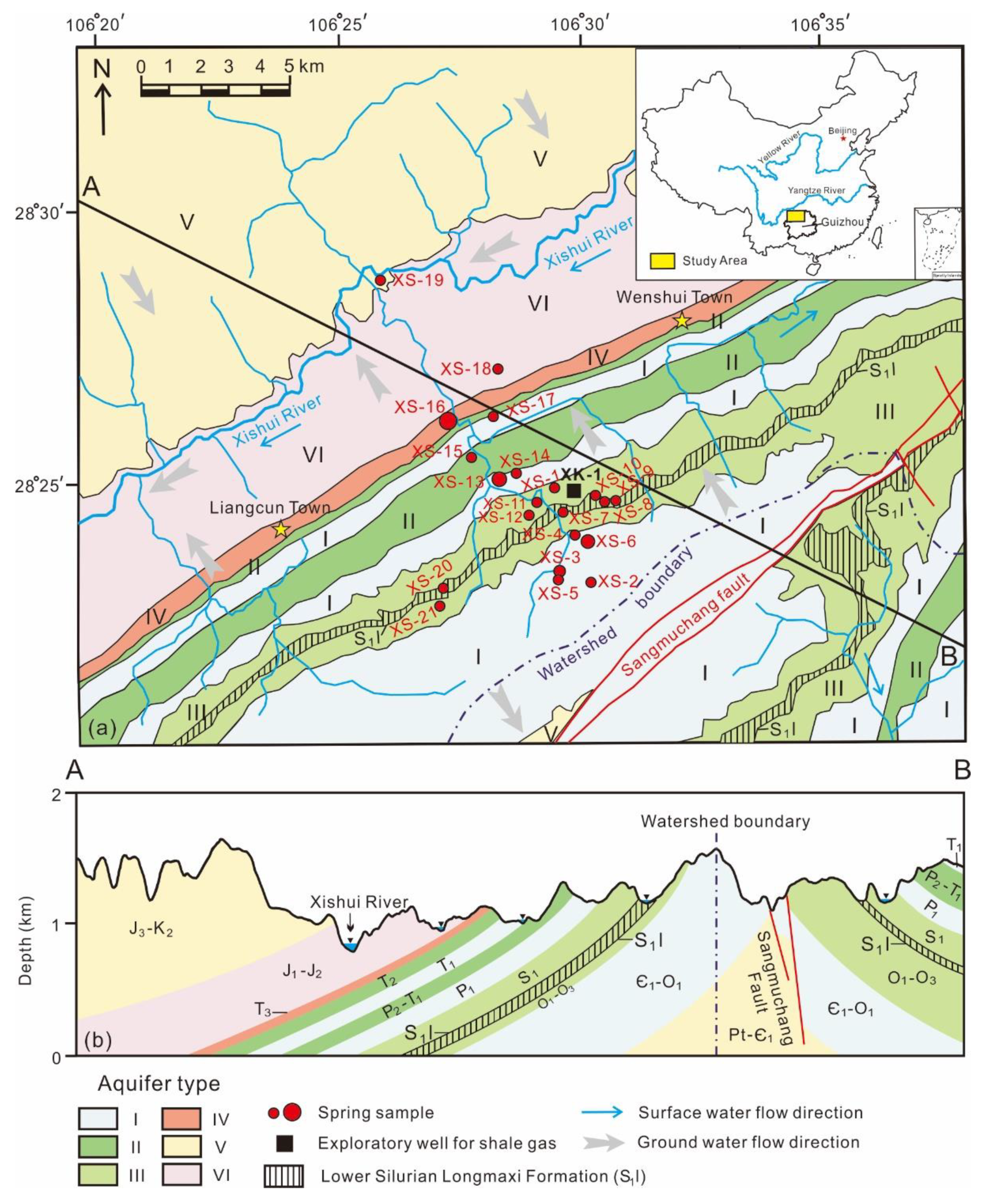
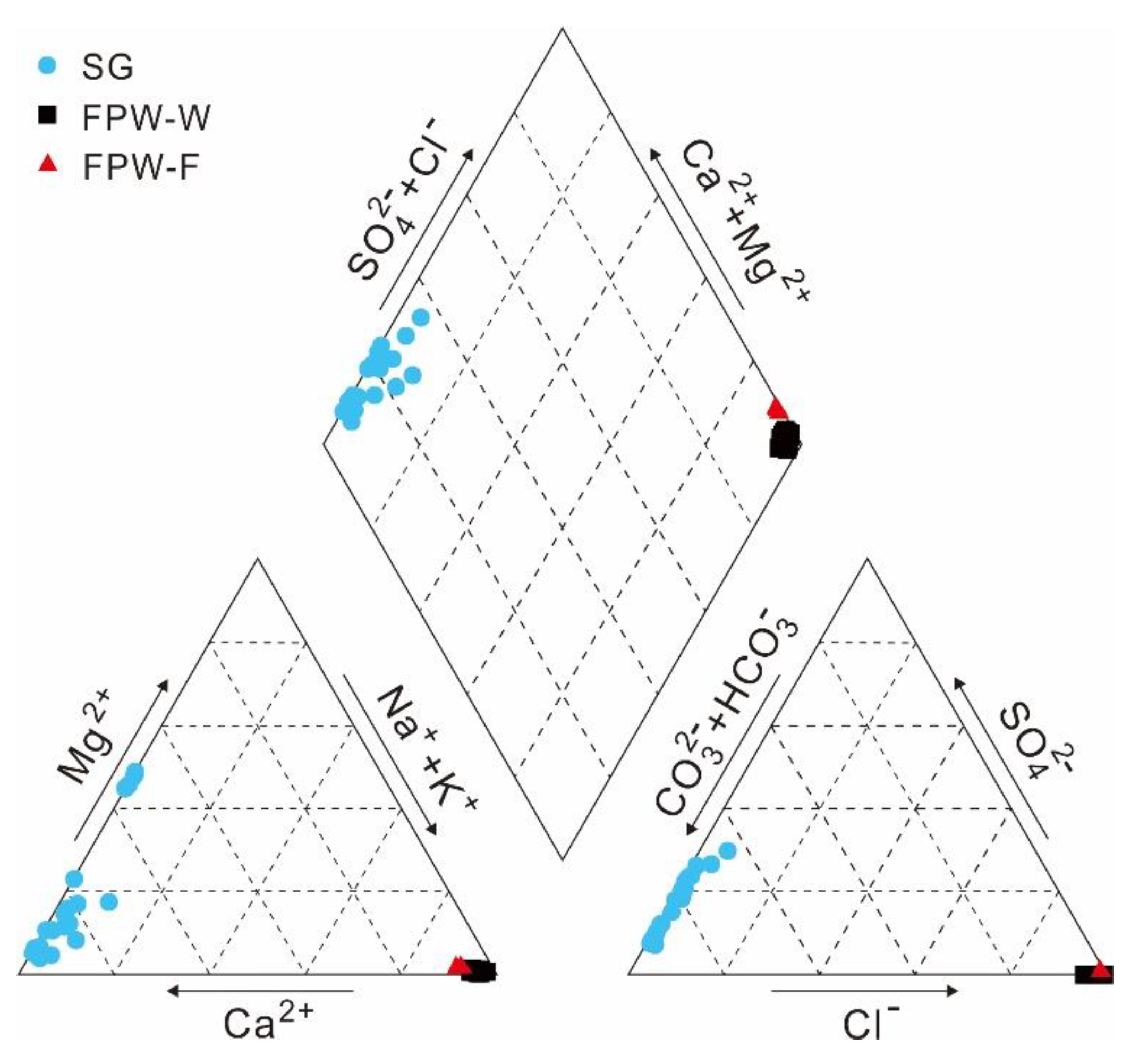

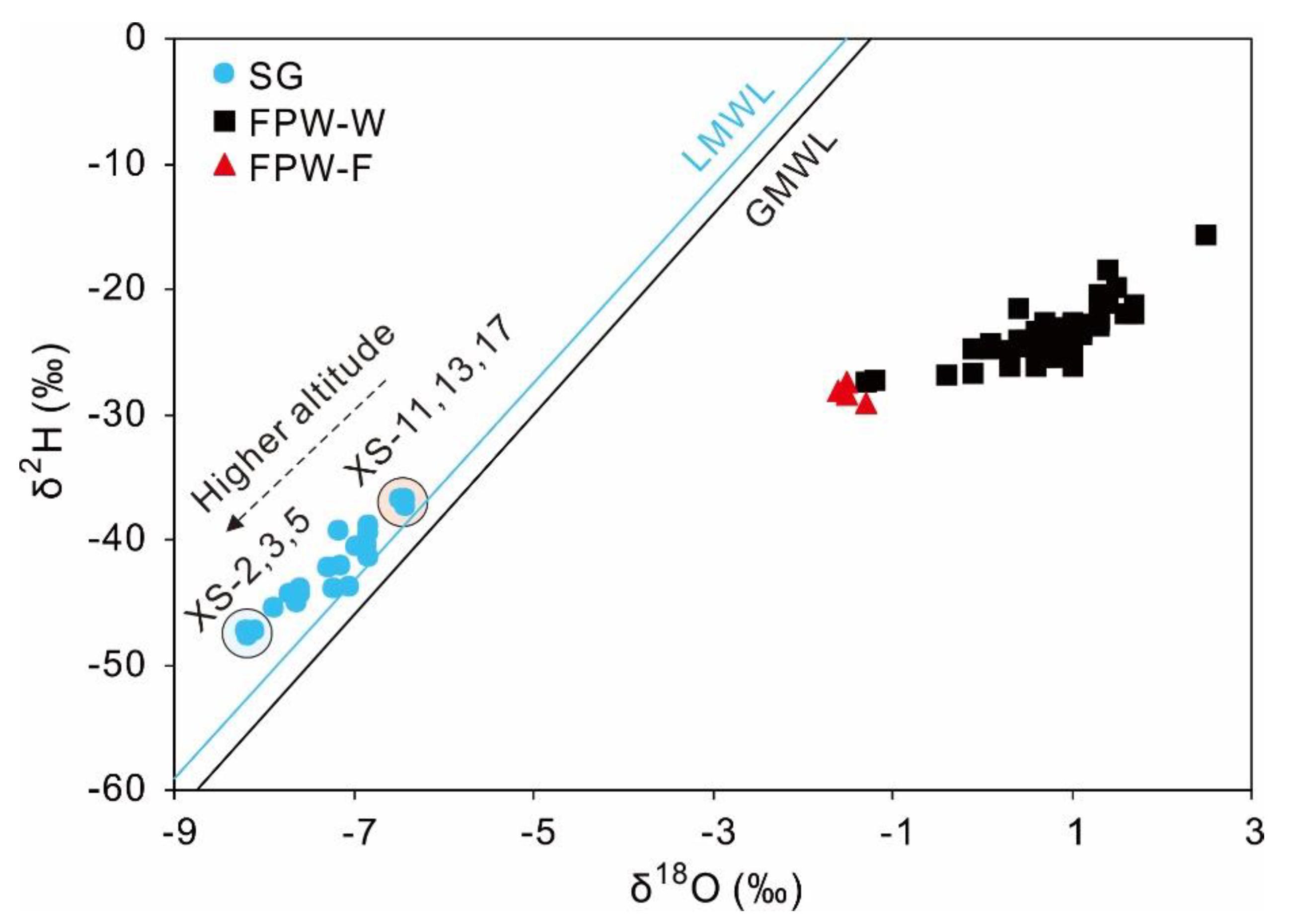
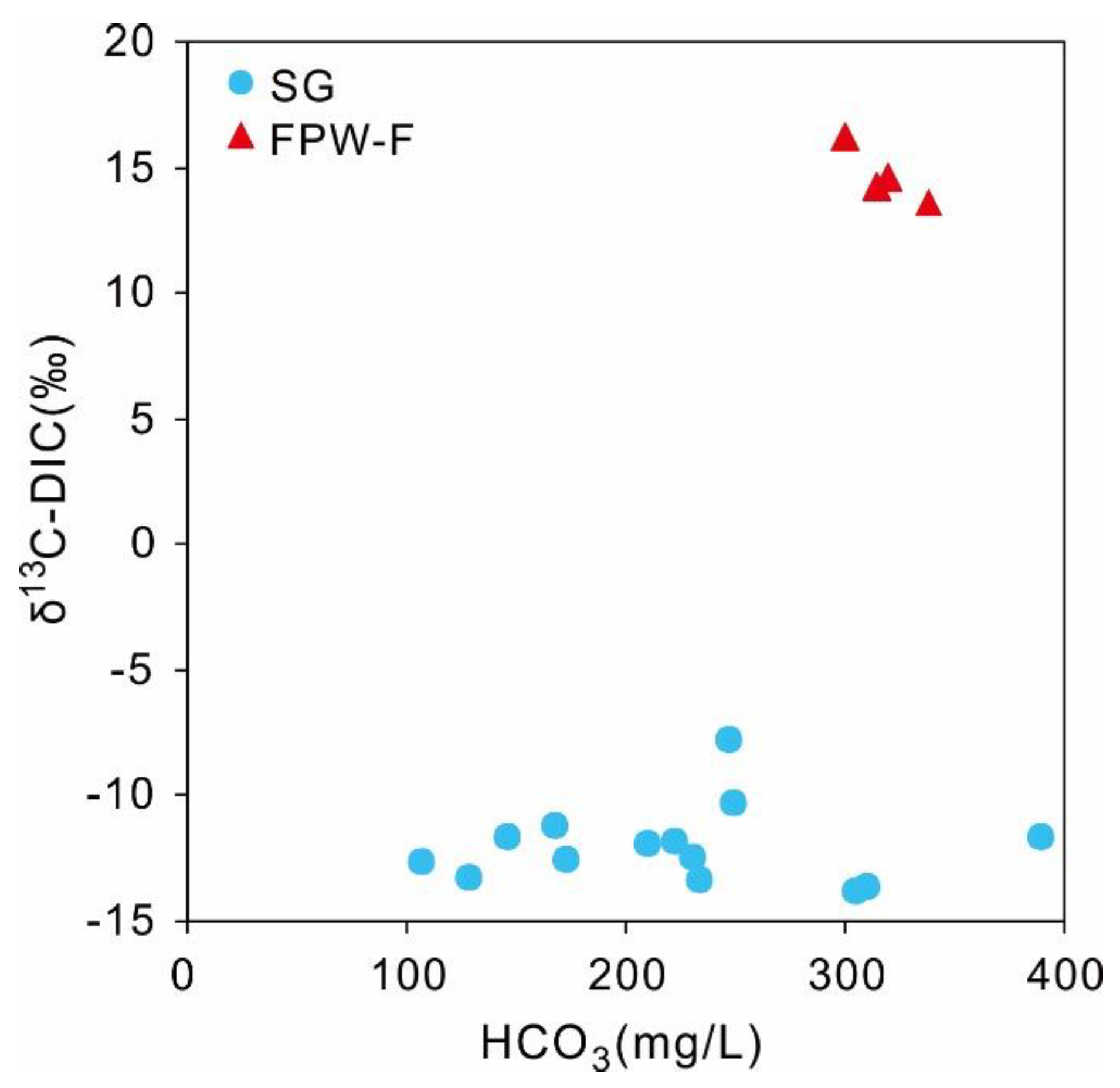

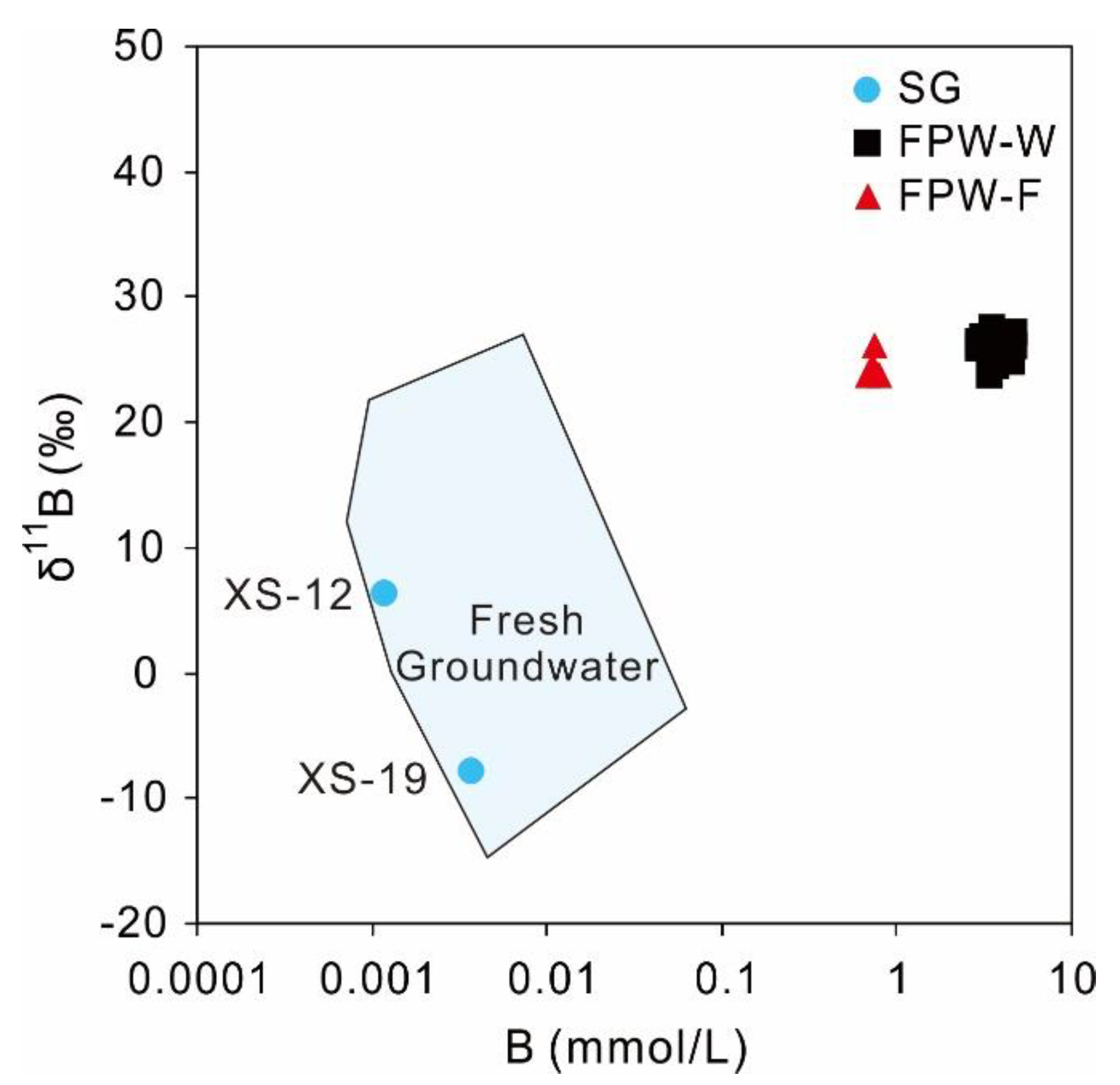

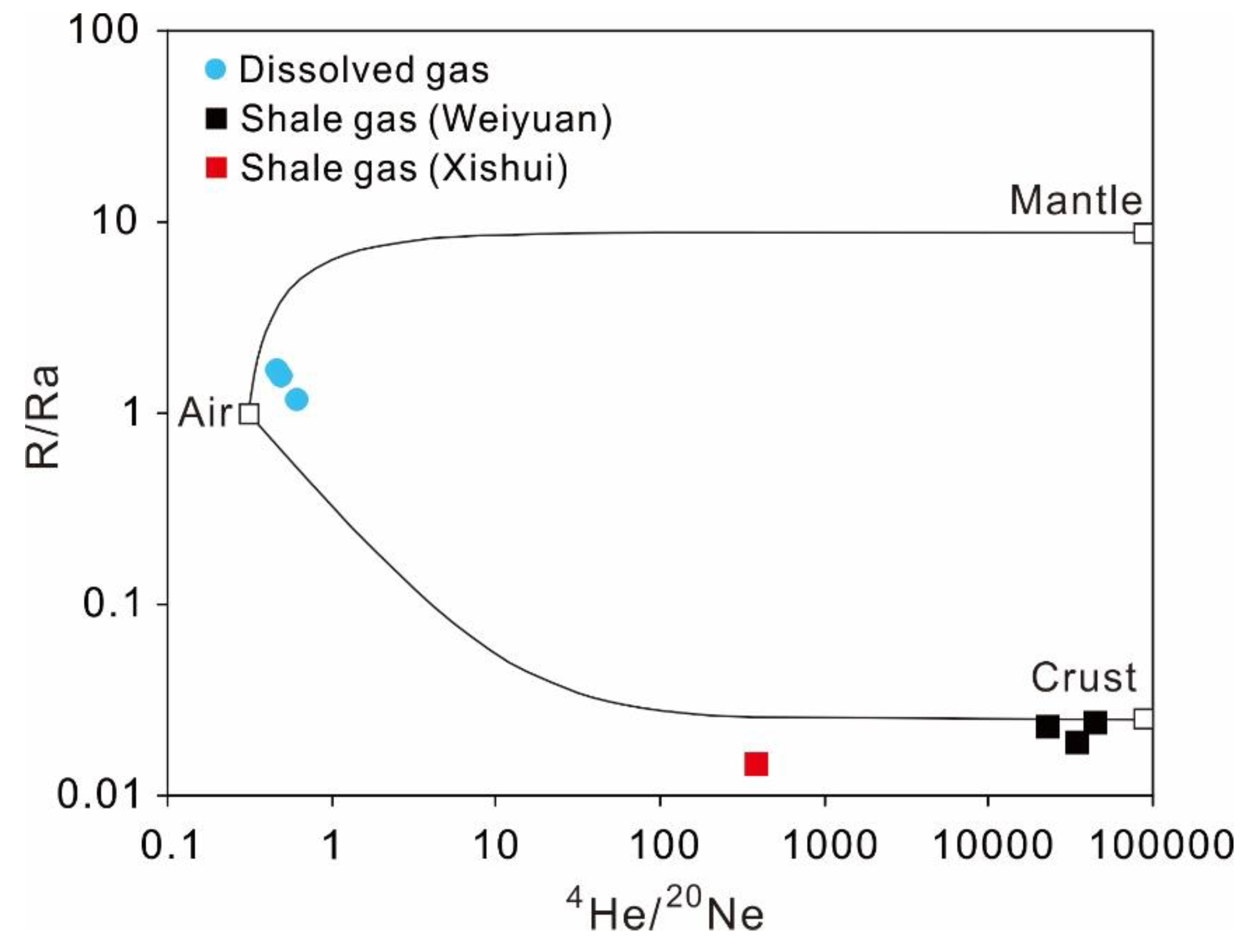
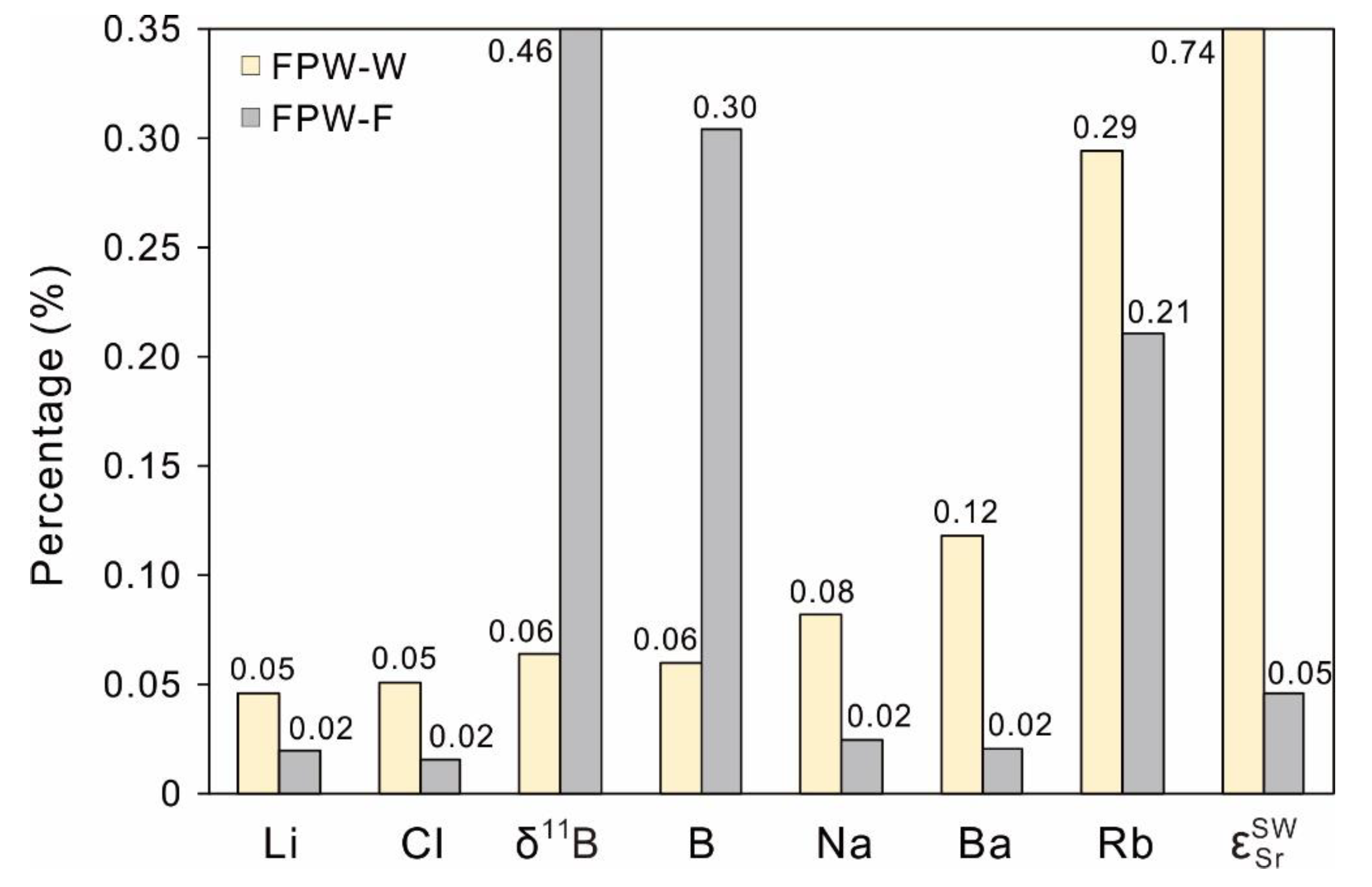
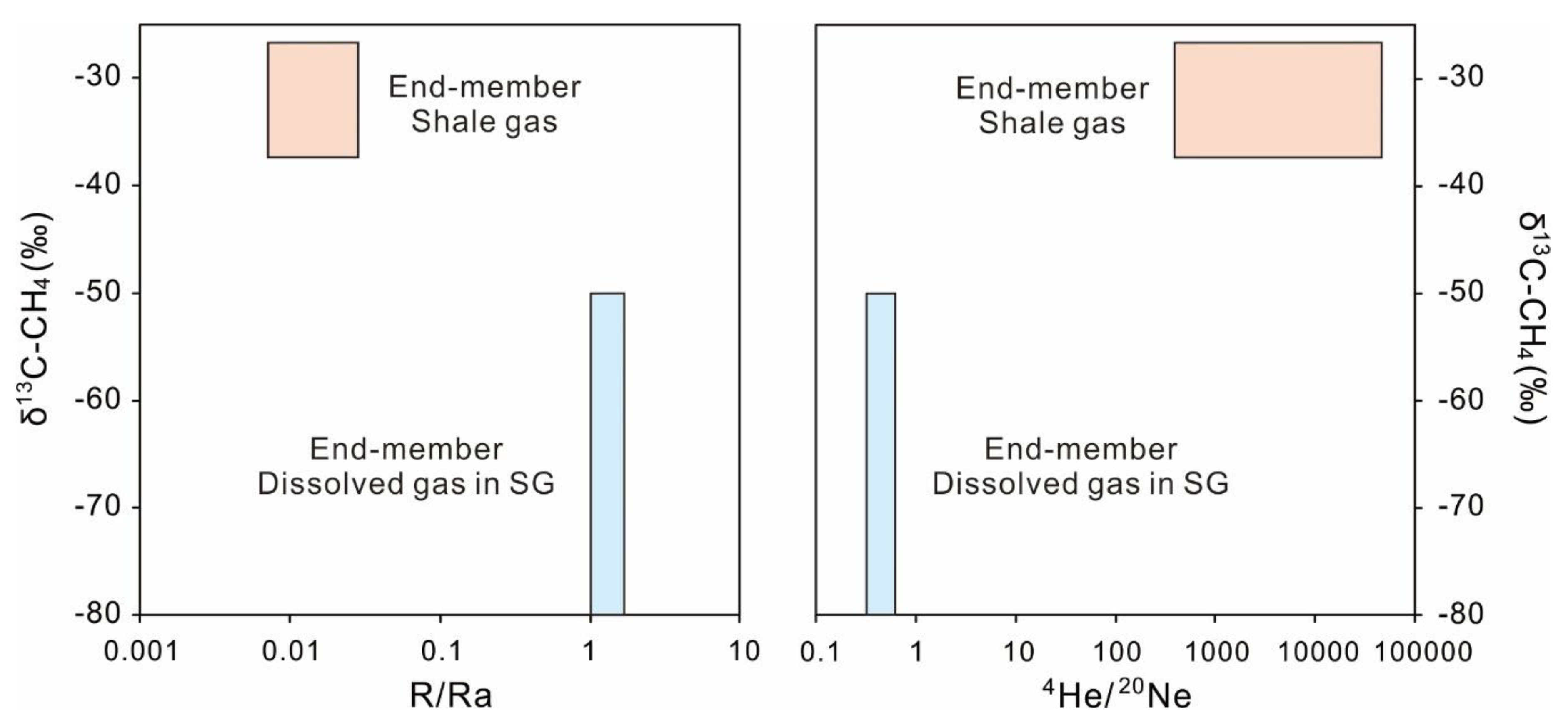
| Sample ID | Water Type | T (°C) | pH | EC (μs/cm) | ORP (mV) | TDS (mg/L) | Major Ions (mg/L) | Trace Elements (μg/L) | |||||||||||
| Ca | Mg | Na | K | HCO3 | SO4 | NO3 | F | Cl | Br | Ba | Sr | Rb | |||||||
| XS-1 | HCO3-Ca | 23.1 | 8.10 | 277 | −46 | 170 | 56 | 2.2 | 0.1 | 0.3 | 173 | 18 | 0.2 | 0.8 | 0.1 | <20 | 37.6 | 94 | 0.24 |
| XS-2 | HCO3-Ca·Mg | 15.5 | 8.07 | 350 | −14.9 | 218 | 44 | 22.3 | <0.05 | 0.7 | 210 | 37 | 2.8 | 1.0 | 0.1 | 20 | 17.7 | 760 | 0.56 |
| XS-3 | HCO3-Ca·Mg | 16.6 | 7.76 | 398 | −26.3 | 240 | 50 | 24.7 | <0.05 | 0.5 | 215 | 48 | 2.4 | 0.8 | 0.1 | <20 | 11.6 | 913 | 0.58 |
| XS-4 | HCO3-Ca·Mg | 19.0 | 8.13 | 276 | −45.1 | 168 | 32 | 18.5 | <0.05 | 0.7 | 178 | 15 | 4.6 | 1.0 | 0.1 | <20 | 25.8 | 246 | 0.54 |
| XS-5 | HCO3-Ca·Mg | 15.8 | 7.74 | 370 | −21.7 | 241 | 50 | 24.9 | <0.05 | 0.5 | 210 | 51 | 1.7 | 0.9 | 0.1 | <20 | 12.9 | 1038 | 0.61 |
| XS-6 | HCO3-Ca·Mg | 16.3 | 7.92 | 247 | −31.5 | 159 | 32 | 18.0 | <0.05 | 0.6 | 168 | 16 | 2.9 | 0.9 | 0.1 | 100 | 26.1 | 101 | 0.49 |
| XS-7 | HCO3-Ca | 17.8 | 7.35 | 328 | −1.5 | 230 | 75 | 2.0 | 2.0 | 1.2 | 222 | 13 | 8.4 | 2.5 | 0.1 | 1000 | 52.7 | 119 | 0.29 |
| XS-8 | HCO3-Ca | 17.6 | 7.59 | 343 | −14.1 | 235 | 76 | 3.3 | 1.1 | 0.4 | 234 | 26 | 1.8 | 1.3 | 0.1 | <20 | 38.3 | 177 | 0.22 |
| XS-9 | HCO3-Ca | 22.5 | 8.01 | 366 | −38.3 | 235 | 72 | 5.4 | 1.8 | 0.6 | 198 | 39 | 6.1 | 2.4 | 0.1 | <20 | 53.1 | 239 | 0.46 |
| XS-10 | HCO3-Ca | 17.8 | 7.44 | 429 | −5.7 | 286 | 82 | 9.6 | 2.6 | 0.9 | 249 | 50 | 5.5 | 1.4 | 0.1 | <20 | 56.2 | 419 | 1.00 |
| XS-11 | HCO3-Ca | 17.6 | 7.20 | 426 | +5.5 | 287 | 99 | 3.3 | 0.7 | 0.2 | 305 | 22 | <0.05 | 1.1 | 0.1 | <20 | 171 | 159 | 0.14 |
| XS-12 | HCO3-Ca | 18.1 | 7.12 | 514 | +10 | 370 | 108 | 11.5 | 3.2 | 0.7 | 390 | 36 | 3.2 | 1.4 | 0.1 | <20 | 123 | 637 | 0.76 |
| XS-13 | HCO3-Ca | 21.6 | 8.15 | 397 | −50.4 | 235 | 72 | 5.3 | 0.6 | 0.1 | 207 | 38 | 4.5 | 2.9 | 0.3 | <20 | 9.4 | 621 | 0.21 |
| XS-14 | HCO3-Ca·Mg | 20.4 | 8.29 | 338 | −57.6 | 210 | 43 | 24.9 | <0.05 | 0.3 | 231 | 19 | 2.9 | 1.1 | 0.1 | <20 | 5.1 | 18 | 0.35 |
| XS-15 | HCO3-Ca | 18.1 | 7.66 | 426 | −22.2 | 397 | 76 | 6.9 | 5.0 | 0.8 | 146 | 54 | 63.9 | 7.6 | 0.2 | <20 | 51.4 | 256 | 0.39 |
| XS-16 | HCO3-Ca | 17.8 | 7.67 | 415 | −22.9 | 268 | 76 | 13.8 | <0.05 | 0.9 | 288 | 19 | 3.4 | 1.6 | 0.1 | <20 | 50.0 | 119 | 0.87 |
| XS-17 | HCO3-SO4-Ca | 18.1 | 7.27 | 540 | +1.6 | 259 | 101 | 8.5 | 4.1 | 2.8 | 247 | 74 | 28.4 | 7.9 | 0.1 | <20 | 20.2 | 1091 | 1.28 |
| XS-18 | HCO3-SO4-Ca | 21.4 | 8.19 | 210.1 | −50.4 | 143 | 34 | 5.0 | 5.2 | 0.6 | 108 | 30 | <0.05 | 0.9 | 0.2 | 20 | 67.7 | 151 | 0.21 |
| XS-19 | HCO3-Ca | 18.7 | 7.39 | 549 | −6 | 379 | 103 | 13.4 | 6.0 | 0.7 | 310 | 77 | 7.5 | 2.9 | 0.2 | <20 | 236 | 1969 | 0.38 |
| XS-20 | HCO3-Ca | 15.2 | 7.93 | 235 | −36.7 | 155 | 48 | 1.5 | 1.6 | 2.3 | 129 | 19 | 10.5 | 1.4 | 0.1 | <20 | 23.5 | 79 | 1.59 |
| XS-21 | HCO3-Ca | 18.0 | 7.25 | 152.3 | +0.2 | 102 | 26 | 1.6 | 2.1 | 1.5 | 78 | 16 | 0.2 | 0.8 | 0.1 | 100 | 32.2 | 127 | 2.30 |
| Sample ID | Trace Elements (μg/L) | CH4 (mg/L) | SI-Calcite | PCO2 | δ18O (‰) | δ2H (‰) | δ13C-DIC (‰) | 87Sr/86Sr | δ11B (‰) | ||||||||||
| Li | B | Cu | Zn | ||||||||||||||||
| XS-1 | 0.24 | 2.92 | 0.50 | 6.64 | <0.01 | 0.70 | 10−2.80 | −6.8 | −39.5 | −12.6 | 0.71058 | 19.9 | |||||||
| XS-2 | 0.53 | 3.89 | 0.08 | 4.15 | <0.01 | 0.51 | 10−2.74 | −8.1 | −47.3 | −12.0 | 0.70917 | −0.01 | |||||||
| XS-3 | 0.63 | 3.01 | 0.32 | 9.45 | <0.01 | 0.28 | 10−2.41 | −8.2 | −47.3 | ||||||||||
| XS-4 | 0.05 | 3.13 | 0.07 | 2.57 | <0.01 | 0.45 | 10−2.84 | −7.7 | −44.4 | ||||||||||
| XS-5 | 0.72 | 2.79 | 0.05 | 1.02 | <0.01 | 0.24 | 10−2.40 | −8.2 | −47.7 | ||||||||||
| XS-6 | 0.06 | 1.82 | 0.35 | 2.49 | <0.01 | 0.18 | 10−2.67 | −7.6 | −44.3 | −11.2 | 0.71236 | 45.0 | |||||||
| XS-7 | 1.53 | 6.44 | 0.15 | 1.99 | <0.01 | 0.11 | 10−1.97 | −7.1 | −43.8 | −11.9 | 0.71222 | 43.0 | |||||||
| XS-8 | 0.58 | 4.87 | 0.15 | 4.01 | <0.01 | 0.36 | 10−2.19 | −7.0 | −40.6 | −13.4 | 0.71202 | 40.2 | |||||||
| XS-9 | 0.98 | 5.26 | 0.28 | 2.07 | <0.01 | 0.74 | 10−2.66 | −6.8 | −38.9 | ||||||||||
| XS-10 | 4.76 | 9.84 | 0.17 | 1.00 | <0.01 | 0.25 | 10−2.02 | −7.6 | −45.0 | −10.3 | 0.71071 | 21.8 | |||||||
| XS-11 | 0.06 | 1.39 | 0.07 | 0.83 | <0.01 | 0.18 | 10−1.69 | −6.4 | −37.4 | −13.8 | 0.71159 | 34.2 | |||||||
| XS-12 | 5.88 | 12.7 | 52.5 | 41.7 | <0.01 | 0.23 | 10−1.51 | −7.1 | −42.1 | −11.6 | 0.71037 | 16.9 | 6.44 | ||||||
| XS-13 | 0.07 | 1.21 | 0.13 | 0.80 | <0.01 | 0.88 | 10−2.79 | −6.5 | −36.8 | ||||||||||
| XS-14 | 0.06 | 1.05 | 0.45 | 163 | <0.01 | 0.82 | 10−2.90 | −7.6 | −43.9 | −12.5 | 0.71168 | 35.4 | |||||||
| XS-15 | 0.74 | 9.06 | 0.30 | 1.69 | <0.01 | 0.23 | 10−2.46 | −6.8 | −41.4 | −11.7 | 0.70797 | −16.9 | |||||||
| XS-16 | 1.11 | 7.08 | 0.17 | 0.36 | <0.01 | 0.52 | 10−2.19 | −6.9 | −40.5 | 0.70965 | 6.8 | ||||||||
| XS-17 | 0.40 | 7.63 | 0.32 | 4.30 | <0.01 | 0.15 | 10−1.85 | −6.4 | −36.9 | −7.8 | 0.70801 | −16.4 | |||||||
| XS-18 | 0.41 | 8.69 | 0.56 | 1.08 | <0.01 | 0.36 | 10−3.11 | −7.3 | −42.2 | −12.7 | 0.71270 | 49.8 | |||||||
| XS-19 | 10.6 | 39.3 | 0.86 | 2.52 | <0.01 | 0.38 | 10−1.87 | −7.2 | −43.9 | −13.6 | 0.71111 | 27.4 | −7.79 | ||||||
| XS-20 | 0.21 | 4.20 | 88.1 | 10.1 | <0.01 | 0.25 | 10−2.80 | −7.2 | −39.4 | −13.3 | 0.71283 | 51.6 | |||||||
| XS-21 | 4.10 | 3.25 | 0.16 | 3.01 | <0.01 | -0.82 | 10−2.31 | −7.9 | −45.5 | −12.6 | 0.71034 | 16.5 | |||||||
| Sample ID | N2 (%.vol) | O2 (%.vol) | Ar (%.vol) | CH4 (%.vol) | CO2 (%.vol) | H2S (%.vol) | He (%.vol) | H2 (%.vol) | δ13C-CH4 (‰) | δ13C-CO2 (‰) | R/Ra | 4He/20Ne |
|---|---|---|---|---|---|---|---|---|---|---|---|---|
| XS-1 | 81.05 | 16.96 | 1.34 | 0.008 | 0.636 | UD | UD | −20.4 | ||||
| XS-2 | 76.37 | 21.81 | 1.32 | 0.020 | 0.484 | UD | UD | −53.1 | −20.0 | |||
| XS-3 | 81.62 | 16.33 | 1.38 | 0.023 | 0.646 | UD | UD | |||||
| XS-4 | 78.60 | 19.76 | 1.15 | 0.034 | 0.440 | UD | UD | −19.2 | ||||
| XS-8 | 76.51 | 21.66 | 1.16 | 0.081 | 0.582 | UD | 0.0006 | UD | −50.6 | −20.3 | 1.68 | 0.46 |
| XS-9 | 75.70 | 22.13 | 1.40 | 0.032 | 0.727 | 0.0009 | UD | −51.5 | −20.5 | |||
| XS-11 | 74.63 | 22.02 | 1.41 | 0.006 | 1.924 | UD | UD | |||||
| XS-16 | 81.42 | 15.35 | 1.52 | 0.375 | 1.336 | UD | 0.0009 | UD | −21.1 | 1.19 | 0.61 | |
| XS-17 | 85.32 | 10.69 | 1.58 | 0.149 | 2.261 | UD | 0.0007 | UD | −19.2 | 1.59 | 0.50 | |
| XS-18 | 75.11 | 22.93 | 1.44 | 0.007 | 0.505 | UD | UD | −21.6 | ||||
| XS-19 | 72.57 | 25.04 | 1.43 | 0.003 | 0.958 | UD | UD | −21.9 | ||||
| XS-20 | 72.87 | 25.45 | 1.43 | 0.003 | 0.252 | UD | UD | −20.6 | ||||
| SG-1 | 1.88 | 0.15 | 0.02 | 97.40 | 0.015 | UD | 0.0538 | UD | −31.9 | 0.015 | 383 |
| Indicators | Units | GB5749-2006 | FPW-W | FPW-F | Shallow Groundwater | X1 (%, |Δ| = 3σ) | X2 (%, |Δ| = 3σ) | |||
|---|---|---|---|---|---|---|---|---|---|---|
| Average | Average | Max | Min | Average | 3σ | |||||
| EC | μs/cm | n/a | 31,881.1 | 87,175 | 549 | 152 | 361 | 308 | 0.98 | 0.35 |
| TDS | mg/L | 1000 | 18,628 | 62,075 | 397 | 102 | 237 | 227 | 1.2 | 0.37 |
| Na | mg/L | 200 | 6937 | 21,459 | 6.0 | <0.05 | 2.6 | 5.4 | 0.08 | 0.02 |
| Ca | mg/L | n/a | 228 | 1462 | 108 | 26.4 | 64.5 | 74.6 | 46 | 5.3 |
| Mg | mg/L | n/a | 32 | 172 | 24.9 | 1.5 | 10.8 | 24.5 | 113 | 15 |
| HCO3 | mg/L | n/a | 548 | 318 | 390 | 78 | 214 | 211 | 63 | 203 |
| Cl | mg/L | 250 | 11,575 | 38,756 | 7.9 | 0.8 | 2.0 | 5.9 | 0.05 | 0.02 |
| Br | mg/L | n/a | 66 | 146 | 1.0 | <0.02 | 0.23 | 1.1 | 1.7 | 0.78 |
| B | μg/L | 500 | 39,856 | 7840 | 39 | 1.1 | 6.6 | 23.8 | 0.06 | 0.30 |
| Li | μg/L | n/a | 16,810 | 38,777 | 10.6 | 0.05 | 1.6 | 7.7 | 0.05 | 0.02 |
| Sr | μg/L | n/a | 59,014 | 497,750 | 1969 | 18 | 444 | 1420 | 2.4 | 0.29 |
| Ba | μg/L | 700 | 14,2305 | 810,474 | 236 | 5.1 | 53.4 | 168 | 0.12 | 0.02 |
| Rb | μg/L | n/a | 529 | 737 | 2.3 | 0.1 | 0.6 | 1.6 | 0.29 | 0.21 |
| δ18O | ‰ | n/a | 0.8 | −1.5 | −6.4 | −8.2 | −7.3 | 1.6 | 20 | 28 |
| δ2H | ‰ | n/a | −23.5 | −28.3 | −36.8 | −47.7 | −42.3 | 10 | 53 | 71 |
| δ11B | ‰ | n/a | 26.3 | 24.6 | 6.4 | −7.8 | −0.7 | 21.3 | 0.06 | 0.46 |
| mg/L | n/a | 150 | 209 | 51.6 | −16.9 | 23.5 | 62.9 | 0.74 | 0.05 | |
© 2020 by the authors. Licensee MDPI, Basel, Switzerland. This article is an open access article distributed under the terms and conditions of the Creative Commons Attribution (CC BY) license (http://creativecommons.org/licenses/by/4.0/).
Share and Cite
Li, Z.; Huang, T.; Ma, B.; Long, Y.; Zhang, F.; Tian, J.; Li, Y.; Pang, Z. Baseline Groundwater Quality before Shale Gas Development in Xishui, Southwest China: Analyses of Hydrochemistry and Multiple Environmental Isotopes (2H, 18O, 13C, 87Sr/86Sr, 11B, and Noble Gas Isotopes). Water 2020, 12, 1741. https://doi.org/10.3390/w12061741
Li Z, Huang T, Ma B, Long Y, Zhang F, Tian J, Li Y, Pang Z. Baseline Groundwater Quality before Shale Gas Development in Xishui, Southwest China: Analyses of Hydrochemistry and Multiple Environmental Isotopes (2H, 18O, 13C, 87Sr/86Sr, 11B, and Noble Gas Isotopes). Water. 2020; 12(6):1741. https://doi.org/10.3390/w12061741
Chicago/Turabian StyleLi, Zhenbin, Tianming Huang, Baoqiang Ma, Yin Long, Fen Zhang, Jiao Tian, Yiman Li, and Zhonghe Pang. 2020. "Baseline Groundwater Quality before Shale Gas Development in Xishui, Southwest China: Analyses of Hydrochemistry and Multiple Environmental Isotopes (2H, 18O, 13C, 87Sr/86Sr, 11B, and Noble Gas Isotopes)" Water 12, no. 6: 1741. https://doi.org/10.3390/w12061741
APA StyleLi, Z., Huang, T., Ma, B., Long, Y., Zhang, F., Tian, J., Li, Y., & Pang, Z. (2020). Baseline Groundwater Quality before Shale Gas Development in Xishui, Southwest China: Analyses of Hydrochemistry and Multiple Environmental Isotopes (2H, 18O, 13C, 87Sr/86Sr, 11B, and Noble Gas Isotopes). Water, 12(6), 1741. https://doi.org/10.3390/w12061741







